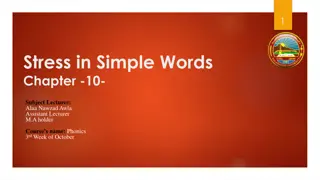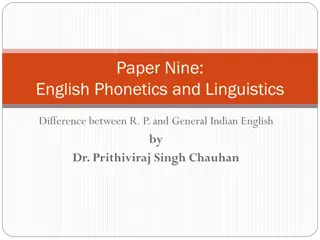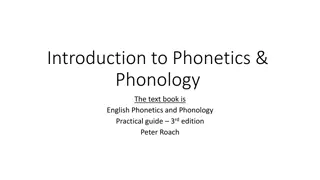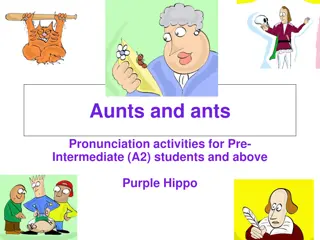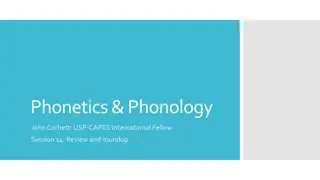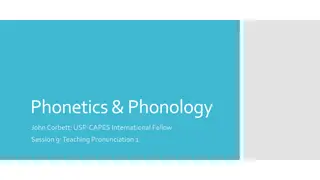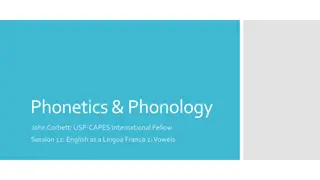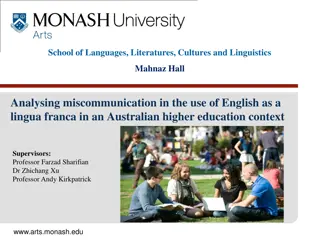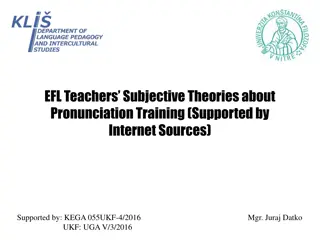Understanding English as a Lingua Franca and Pronunciation Teaching
This session explores English as a Lingua Franca (ELF) and the importance of focusing on mutual intelligibility in English pronunciation teaching. It discusses the sociolinguistic context of L2 speakers interacting with each other, emphasizing the need for tailored pronunciation models. The session also delves into the concept of intelligibility and its key factors for effective communication.
Download Presentation

Please find below an Image/Link to download the presentation.
The content on the website is provided AS IS for your information and personal use only. It may not be sold, licensed, or shared on other websites without obtaining consent from the author. Download presentation by click this link. If you encounter any issues during the download, it is possible that the publisher has removed the file from their server.
E N D
Presentation Transcript
Phonetics & Phonology John Corbett: USP-CAPES International Fellow Session 11: English as a Lingua Franca 1: Consonants
This session: What is ELF (English as a Lingua Franca)? What is the LFC (Lingua Franca Core)? What are the LFC recommendations for teaching the consonants of English Today s session
Questions to answer: Why are you learning English? Are you more likely to use English with a native speaker or an L2 English speaker? What kind of pronunciation model would be most useful in your likely contexts of use? The sociolinguistic context
http://www.ethnologue.com/language/eng 58,100,000 in United Kingdom, all users. L1 users: 56,600,000 (2011 census). L2 users: 1,500,000 (Crystal 2003a). The sociolinguistic context: Global English 308,900,000 in United States, all users. L1 users: 261,000,000 (2016). L2 users: 47,900,000 (2013). Total users in all countries: 1,121,806,280 as L1: 378,250,540; as L2: 743,555,740.
http://www.ethnologue.com/language/eng Total users in all countries: 1,121,806,280 as L1: 378,250,540; as L2: 743,555,740. The sociolinguistic context: Global English Conclusion: L2 speakers of English are much more likely to interact with other L2 speakers of English than with L1 speakers. L2-L2 interaction is ELF. Why, then, focus strictly on L1 models of pronunciation?
Published in 2000 Promised a new approach to English pronunciation teaching` Focus on mutual intelligibility among non- native speakers as the goal of teaching and curriculum design Uses empirical data to determine whichsounds cause problems of intelligibility which sounds are at the root of communication breakdown? What is ELF?
Intelligibility is a complex phenomenon that depends on issues such as: Recognition and interpretation of meaningful contrasts in sound Shared context of knowledge What is intelligibility?
L2-L2 Interaction (a German and Japanese speaker) J has mentioned let cars. Example of communication breakdown & repair with little or no shared context G: I don t understand the let cars. What do you mean with this. J: Let [l t] cars? Three red [ d] cars (very slowly). G: Ah, red. J: Red. G: Now I understand. I understood car to hire, to let. Ah, red, yeah, I see.
One the basis of her analysis of many L2-L2 speaker interactions, Jenkins proposes a Lingua Franca Core . This is a set of recommendations for pronunciation teaching based on which sounds seemed to cause communication breakdown in contexts where there was little or no shared knowledge What is LFC? The LFC is still based on RP and GenAm models but allows for variation between them and the focus is on intelligibility. Substitutions that do not affect intelligibility are recommended.
Allow substitutions for // and // Substitution of /d/ or /v/ and /t/ or /f/ in words like <this, think> does not affect intelligibility. Many L1 accents also make this substitution. LFC consonants: Allow substitutions for dark [ ] Substitution of clear [l] or even vocalised [ ] in words like <milk, bottle> does not affect intelligibility. Major L1 accents (like Estuary English) also make vocalise [ ]>[ ] though it might cause problems in America. Recommendations
Encourage the use of GenAm [] and a rhotic accent A rhotic accent keeps spelling-sound correspondences. GenAm voiced retroflex approximant ( caipira r ) is widespread amongst L1 speakers Use of GenAm [ ] reduces the number of diphthongs and triphthongs to be learned. LFC consonants Recommendations Encourage intervocalic [t] rather than the voiced alveolar flap [ ] In words like <matter>, the RP [t] phoneme is preferred because the GenAm [ ] causes confusion with voiced [d] : <matter> is confused with <madder>
Encourage aspirated initial voiceless plosives [p], [t] and [k] If learners do not aspirate voiceless plosives, they are confused with voiced plosives, e.g. <pig, big> are confused. LFC consonants Train learners to shorten vowels before voiceless/fortis consonants, so the first vowel is slightly shorter in the minimal pairs /p k/ and /p g/ or /si:t/ and /si:d/. Maintain the length before a final voiced/lenis consonant The length of vowels seems to cause communication breakdown at times. L1 speakers automatically shorten the vowels before unvoiced consonants, so encourage L2 speakers to do the same in words like <leaf>, <leak> and <sweet> as opposed to <leave>, <league> and <Swede>. Recommendations
Allow additional unstressed (epenthetic) vowels in consonant clusters. Additional unstressed vowels in consonant clusters don t usually cause intelligibility problems, so don t worry about them. You can say / w k d/ and / spe s/ LFC consonant clusters: Insist onfull consonant clusters at the beginnings of words. Some Asian learners say [ p d k] for <product> and that causes problems. There is no intelligibility issue with [ p d k] Recommendations
Allow simplification by deletion, especially of /t/ and /d/, in the middle and ends of words This is a general feature of L1 RP and GenAmtoo, e.g. you can delete the medial /t/ in <fact-sheet> and the /d/ in <friendship>. LFC consonant clusters: Follow RP in NOT reducing clusters with intervocalic /nt/ to /n/ in words like <international> or <twenty>. Americans often do elide here but it can cause problems with spelling-pronunciation correspondences. Recommendations
In general, use the consonant in your own phonemic inventory that is closest to the corresponding L1 consonant. However, some transfers cause problems, e.g. Spanish speakers use a voiced bilabial fricative [ ] for the voiced bilabial plosive [b], especially between vowels, and this sounds like the voiced labiodental fricative [v]. So there can be a confusion between <habit, have it> and <a berry, a very>. Spanish and Portuguese speakers (and also Greeks) transfer their use of voiced [x] to voiceless [h] in words like <house> and this can cause intelligibility issues. Forbidden substitutions
Almost 20 years after the publication of Jenkins book, the recommendations and the principles behind them remain controversial. Watch this 10-minute video about teaching pronunciation with the LFC. How should teachers use the LFC with international coursebooks? Do you agree? LFC in action http://www.youtube.com/watch?v=iERCcsdfoRs
ELF invites us to readjust our assumptions about why we are teaching and learning English and what kind of pronunciation is acceptable. The LFC argues that pronunciation models should not be about correctness based on any one L1 model. Summing up Instead, pronunciation teaching should draw upon a rational , evidence-based model that takes intelligibility as its main goal. This model (a) is based on a mixture of RP and GenAm; (b) recommends substitutions to promote learnability when intelligibility is not compromised, and (c) allows for variationin accents.
Next week we look at the LFC recommendations for vowels and vowel length We ask if intelligibility is a sufficient goal for pronunciation teaching Next week



